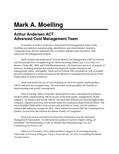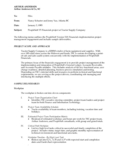咨询方法与工具资料库SYSCNCPT【精品文档】
- 格式:doc
- 大小:53.00 KB
- 文档页数:5

BELL SYGMA INC. : SOFTWARE SELECTION 1995Saturday, May 12, 2018PURCHASE ORDER REQUIREMENTSOVERALL REQUIREMENTS (3)Integration (3)Migration (3)V ENDOR T ABLE (4)Q UOTATION E NTRY (4)P URCHASE O RDER E NTRY (5)Validation (5)Processes on Purchase Order Entry (6)Tax Processes (7)Receipts (7)Inventory Features (7)Advanced Purchase Order Features (8)Advanced Foreign Currency Features (9)REPORTING FEATURES (9)Standard Features (9)Vendor Reports (9)Transaction Reports (10)Financial Reports (11)Advanced Reporting Features (12)System Reports (12)CASH FORECASTING (12)POSTING&CLOSING PROCEDURES (13)FIELDS AVAILABLE (13)PURCHASE ORDER REQUIREMENTSReference Information (13)Transaction Dates (14)Descriptive Information (15)Shipping Detailed Information (16)Numeric Information (16)Discount Information (17)Transaction Type Identifier (17)PURCHASE ORDER REQUIREMENTSOVERALL REQUIREMENTSPurchase orders result from/in legal agreements with vendors. There are standard service “products” that Bell Sygma purchases. These require standard descriptions. Support for this in purchase order entry should be described. Tax calculations are a key area for system processing improvements. Taxes should be calculated by the system on a line item basis. EDI is a long term objective.The system needs to include flexibility for the future products inventory that business may create. Details for this have been included under accounts receivable functional requirements.Depending on the architecture of the new system, some of these requirements may be handled differently. Please describe how it would work with your product’s architecture.IntegrationMigration。

Mark A. MoellingArthur Andersen ACTAdvanced Cost Management TeamA member of Arthur Andersen's Advanced Cost Management Team, Mark Moelling specializes in manufacturing, distribution, and retail industry practices. Companies from diverse industries re ly on Mark’s initiative and experience with advanced cost management projects.Mark designs and implements Activity-Based Cost Management (ABCM) systems and business process re-engineering for clients including Dana Corp, Coca Cola, Levi Strauss, Violex BIC, IBM, and PAR Pharmaceutical. His experience spans on all aspects of business, including product and market development, human resources, site management, safety, and quality. Mark served Fortune 500 companies as well as smaller growth companies as a senior manager in the Business Consulting Services Group in the Dallas office of Arthur Andersen.Mark introduced the use of storyboarding as a tool for rapidly implementing ABCM and process re-engineering. His innovative work quantifies the benefits of implementing total quality management.Prior to joining Arthur Andersen, Mark spent 12 years with Johnson & Johnson Medical (JJMI), implementing ABCM as part of the total quality management (TQM) initiative. He formed and led the ABCM core team that defined activities throughout the company, mapped processes, and formed teams for continuous improvement efforts. The team identified $100 million in non-value add activities or waste, and the initiative realized $40 million in savings for JJMI. These initiatives earned JJMI the Commitment to Quality Award from the Johnson & Johnson Family of Companies.Mark served as an instructor for Executive Enterprises and the American Management Association. An international speaker on activity-based costing, he presented “The Relationship of ABC to World Class Manufacturing” for AIC Conferencias in Mexico City.Mark is a CPA and a CMA with a bachelor's degree in Accounting from the University of Texas at Arlington. He is a Texas Society of CPAs Accounting Excellence Award winner.。


ARTHUR ANDERSENArthur Andersen & Co, SCTo:FilesFrom:Nancy Schuster and Jenny Yao, Atlanta BCDate:January 3, 1995Subject:PeopleSoft V5 Financials project at Tractor Supply CompanyThe following memo outlines the PeopleSoft Version 5.01 Financials implementation project management engagement and includes sample deliverables.PROJECT SCOPE AND APPROACHTractor Supply Company is a $300M retailer of farm equipment and supplies. Withover 180 retail stores across the Midwest and South, TSC is custom developing a point-of-sale and sales audit system concurrently with the implementation of PeopleSoftFinancials.The primary focus of the financials engagement is to provide project management of the implementation and integration of Peop leSoft’s General Ledger, Accounts Receivable,and Accounts Payable modules. This includes analysis of the key functional areas, user change readiness, detailed planning, business process simulation and testing.Depending on TSC’s internal skills and resources to perform technical and functionalrequirements, we are serving as the project drivers, coordinating role managing andinterfacing the multiple efforts.SAMPLE DELIVERABLESWorkplanThe workplan is broken out into eleven components:I. Project Team Organization Chart∙Identifies TSC executive steering committee, project team leaders and project team for both Finance and Information Technology.II. Project Team Availability Schedule∙Tracks availability of team members, including training, vacation time and holidays.III. Estimated Project Team Participation Matrix∙Breakout of estimated workdays and hours per week for TSC project team, Arthur Andersen, and PeopleSoft consultants, with group and grand totals.IV. Critical Path Workplan∙List key high level tasks critical to successful and timely completion of the project. Includes status, target date, and graphic monthly representation oftechnical environment and functional area tasks.V. Workplan Timeline - By High Level Task∙Broken out into G/L, A/R and A/P with expected start and completion dates and Gantt chart representation.Date:January 3, 1996Subject: PeopleSoft Version 5 Financials project at TSCVI. Workplan Timeline - By High Level Function∙Same as above.VII. Workplan Timeline - By Function With Detail∙Same as above.VIII. Technical Resources Workplan∙Lists both high level functions and tasks with key deliverables, start and finish dates and status. TSC, AA and PeopleSoft resources and estimatedwork days charted and totaled.IX. General Ledger Workplan∙Lists high level functions and tasks in same format as the TechnicalResources workplan.X. Accounts Receivable Workplan∙Same as above.XI. Accounts Payable Workplan∙Same as above.Status reportsProject team leaders meetings∙Weekly meetings are held to address any outstanding issues or concerns.Represented are IT and functional leaders.∙Minutes are documented and distributed afterwards.Executive steering committee meetings∙David Riviere and Nancy Schuster of AA meet with both the controller and vice president of IT weekly to discuss project progress and issues.∙An Executive Status Report is prepared beforehand and serves as an outline for the meeting.- The report is organized by a graphic representation of stoplights,heading each page with red, yellow and green light issues.- Detail is broken out by technical environment, G/L, A/R, and A/P, aswell as the Store System and Sales Audit, two custom developmentprojects.- The report is tied directly to the Critical Path Workplan, which isattached and modified to include critical path status of red, yellow orgreen.Date:January 3, 1996Subject: PeopleSoft Version 5 Financials project at TSCBi-Monthly Status Report∙ A high level, one page color report posted in the Finance Department and distributed to project team members.∙Includes brief, positive remarks on project status that have corresponding stoplights.∙ A “People-o-Meter” bar at the bottom represents the progress of the project.“People-o-Meter” Chart∙Posted in the Finance Department, the “People-o-Meter” is a large, graphic barometer that tracks the completion of critical tasks with PeopleSoftmarkers.。

BELL SYGMA INC. : SOFTW ARE SELECTION 1995Saturday, May 12, 2018THE TECHNICAL ENVIRONMENTOVERVIEW (3)THE PLANNED ARCHITECTURE (3)Three Tier Client/Server Architecture (6)STANDARD OPERATING ENVIRONMENT(SOE) (6)Finance Site (6)Client Work Stations (6)Operating System: (6)Network Connections: (6)Protocol: (7)Remote Asynchronous Access: (7)NOS (Network Operating Systems): (7)Middleware: (7)LANs & WANs (7)Data Base & Application Server (9)File Transfer: (9)Development Tools (9)REQUIRED CAPACITY AND SIZING INFORMATION (10)General Information (10)Concurrent Users (10)Accounts Receivable (10)Accounts Payable (10)General Ledger (11)Purchase Order (11)External Reference Tables (11)TECHNICAL REQUIREMENTS (11)Application size and recommended configuration (12)Hardware Specifications (12)Physical Requirements and Response Times (13)CPP/Security and Recommended Plan (13)Growth and Scalability (14)Network Requirements (14)System and Application Management and Operations (14)Development Tools/Query Tools/Report Tools (14)THE TECHNICAL ENVIRONMENTVendor Hardware/Software Support for Recommended Hardware vendors (15)Software Technical Functionality (15)SUMMARY (15)THE TECHNICAL ENVIRONMENTOVERVIEWThis section describes Bell Sygma’s planned architecture providing system diagrams indicating platforms and interfaces. In a ddition, capacity information is provided. Finally, there are specific technical issues that are to be addressed by the vendor based on the Bell Sygma architecture described.THE PLANNED ARCHITECTUREBell Sygma has a three tier architectural model for system development where the business logic is seperated from the data and the presentation layer. These three tiers could be distributed across one or more physical platforms given the chosen operating environment and resource management policy. Bell Sygma has a Standard Operating Environment (SOE) policy which identifies the hardware, operating system, networked, relational database management system and development tools to be used. This SOE policy ensures that selected hardware and software to be evaluated, proves to be compatible with our existing environment and can be supported internally. The following described in more detail the three tier architecture and SOE variables.。
IntroductionThis document provides a high-level description of the Spreadsheet Interface System (SIS) Analysis and Preliminary Design (Phase I) project. The overall objective of Phase I of the project is to define the requirements and develop a preliminary design for a system that will enable CITGO to utilize existing yield data as input into the Tariff, Inventory and Producibility (TIPS) software. More specifically, the system should create a TIPS-compliant text file for import into TIPS by consolidating the yield data stored in the yield spreadsheets and the APPLY yield accounting system maintained by CITGO’s and CIT-CON’s Yield Departments respectively.The system concept description consists of the following:∙background information∙project organizational charts∙ a system architecture overview∙ a process map∙ a list of the major information provided to and produced by the overall process and ∙ a high-level list of the requirements of a system designed to support the process. Background InformationCITGO has achieved foreign trade zone (FTZ) status. TIPS has been implemented to assist CITGO in meeting all U.S. Customs FTZ reporting and record keeping requirements. In addition, TIPS enables CITGO to maximize duty avoidance and deferral within U.S. Customs approved producibility constraints.Receipt, shipment and consumption data can be input into TIPS manually using the TIPS Spreadsheet Interface. In CITGO’s case, this data resides in approximately fifteen Excel spreadsheets1 and in the APPLY system at CIT-CON. CITGO would like to leverage this information by building an automated interface between the spreadsheet and CIT-CON yield data and TIPS to avoid manual input of data.CITGO has a ten day window in which to supply information to U.S. Customs. Consequently, changes to historical data that are outside of the window will not affect tariffs.Project Organization ChartOrganizational charts for CITGO, CIT-CON and Arthur Andersen are attached. System Architecture OverviewOur analysis has concluded that “the system” consists of four separate, independent systems as described below (please refer to the System Specification for more details):1 In the past, the spreadsheets were built and maintained using Lotus 1-2-3. An effort is currently underway to convert the spreadsheets to Microsoft Excel 5.0 format. Once the conversion is complete, the spreadsheets will be maintained using the Microsoft Excel 5.0 application software.∙CITGO Yield Reporting System (CYRS)∙CIT-CON APPLY System (APPLY)∙Spreadsheet Interface System (SIS)∙Tariff, Inventory and Producibility (TIPS)Process MapA process map has been developed to facilitate the full understanding of the manual and automated processes that will be used by the CITGO Yield Department, CIT-CON Yield Department and the Foreign Trade Zone Coordinator. The initial process map was developed based on information gathered during the initial sales call. Subsequent refinements have been based on interviews held with CITGO personnel and the Arthur Andersen TIPS Implementation Team. Please refer to the Appendix for the process map.SIS Inputs and ProductsSIS has two major inputs:1.The receipt, shipment and consumption transactions residing on the fifteen yieldworkbooks that make up CYRS and2.The receipt and shipment transactions contained within CIT-CON’s APPLY system. The main product of SIS is a TIPS-compliant text file that can be “manually” imported into TIPS.System RequirementsCITGO Yield Reporting System (CYRS)∙CYRS must be able to create a separate text file2 per workbook containing the Product Code, Transaction Date, Key 1, Key 2 (may be blank), Volume, Weight3, Actual API Gravity, Amount Type Indicator, Method of Delivery (may be blank), Receipt/Shipment Type, Filler (blank) and Process Date (may be blank) from each receipt, shipment and consumption transaction.∙CYRS must allow transactions from the current and prior periods to be corrected.The corrections must be entered such that SIS can “understand” them.CIT-CON APPLY∙APPLY must be able to create a text file4 containing all of the transactions contained on a daily RANDSDLY sheet. The RANDSDLY sheet must contain all of the data required to derive the following TIPS information: Product Code, Transaction Date,2 The text file must be created in a standard format such as comma separated values (CSV) or fixed length.3 The weight may be blank in instances where TIPS calculates the weight.4 APPLY creates a tab separated values formatted text file.Key 1, Volume, Weight, Actual API Gravity, Amount Type Indicator andReceipt/Shipment Type.Spreadsheet Interface System (SIS)∙SIS must be able to import the receipt, shipment and consumption transactions contained within the text files created by CYRS and APPLY. In addition, SIS must compare control totals based on the original CYRS transactions versus control totals based on transactions imported from a CYRS text file.∙The FTZ Coordinator must be able to select all or a portion of the CYRS and APPLY text files for import. In addition, SIS must help the FTZ Coordinator determinewhether all of the data required for a zone week is available.∙SIS must be able to create a TIPS-compliant text file containing receipt, shipment and consumption data for import into TIPS.Please refer to the AFES Matrix in the Appendix for further details.。